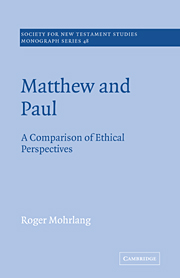3 - Relationship to Christ and the Role of Grace
Published online by Cambridge University Press: 17 August 2009
Summary
In this chapter we shall investigate the ways in which the ethical outlooks of the two writers are shaped by their understanding of the Christian's relationship to Christ (and to the salvation event more generally) and the extent to which this relationship functions as a factor in the motivation of ethics. Special attention will be focused on the role of grace.
Matthew
In the Gospel, this relationship is portrayed primarily in the interaction between Jesus and the twelve disciples. Matthew sees in their relationship to Jesus the relationship of his own community to the κύρωζ, so that, generally speaking, words spoken by Jesus to the Twelve are to be understood as spoken to his own community as well. (There are limits to this principle, however.) The Twelve are presented not so much as models to be imitated, as simply typical or representative disciples, Jesus is the model, not the disciples.
Matthew's View of Jesus
Before examining the disciples' role more closely, we look first at Matthew's portrait of Jesus. Above all, it is Jesus' authority (ἐξουσία) that the evangelist emphasizes, and this is seen in both his words and his deeds.
- Type
- Chapter
- Information
- Matthew and PaulA Comparison of Ethical Perspectives, pp. 72 - 93Publisher: Cambridge University PressPrint publication year: 1984



